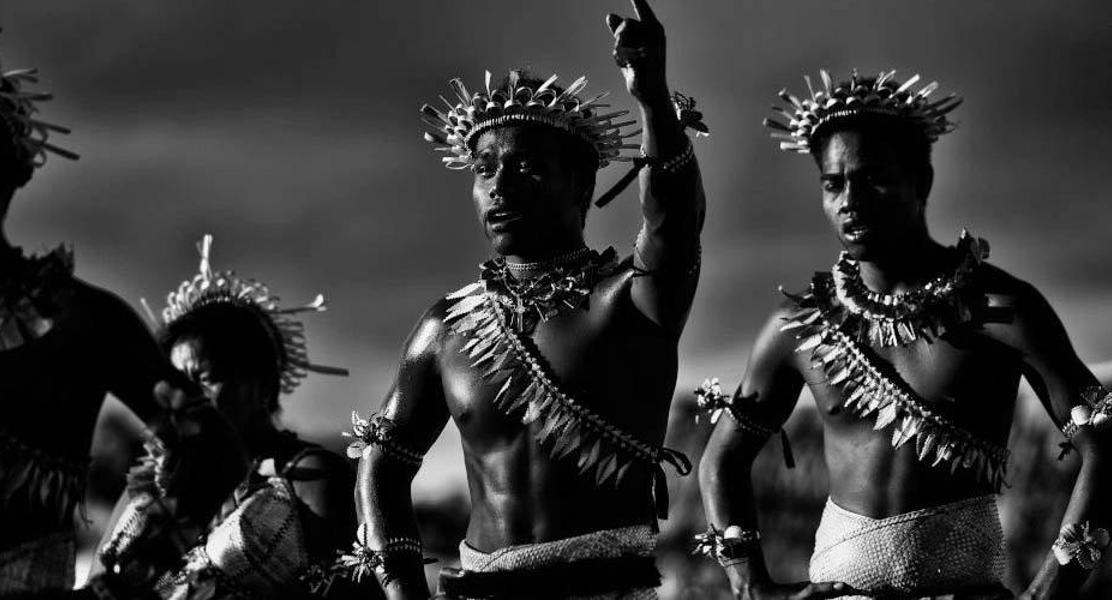

These contemporary artists are just some of the names currently influencing the industry. At the heart of their work: capturing Australia’s rich and diverse Indigenous culture—one snap at a time.
Through photography, multimedia and film, Gunditjmara woman Hayley Millar Baker explores the notion of memories and human experience. The contemporary artist uses research to drive her storytelling methodology, where she reflects on personal recollections and historical accounts that are improvised.
With the use of digitally-assembled photography, Millar Baker constructs complex visuals that sees her storytelling techniques provide new perspectives. She’s been selected as one of the top eight young Australian artists for the Museum of Contemporary Art, Sydney’s Primavera. She’s also won the John and Margaret Baker Fellowship for the National Photography Prize in 2020, the Darebin Art Prize in 2019, and the Special Commendation Award in The Churchie National Emerging Art Prize in 2017.
Tasmanian-born Ricky Maynard has been a fixture in the Australian photography industry since his career began in the '80s. The self-taught photographer made his mark with his 1985 series Moonbird People, which depicted the muttonbirding season on Babel, Big Dog and Trefoil Islands in Tasmania. Maynard’s images explore the stories of Tasmanian history, describing his photographs as proof about “life in passing and in complicated times”, while his intimate portraits show elders from communities in Northern Queensland, portraying each complex story through a series of compelling close-ups.
Darumbal and Yiman man Trent White made the switch from mining to photography in 2010, with a mission to preserve First Nations culture. His work aims to capture the identities of Aboriginal and Torres Strait Islander families and clans across the country, empowering Indigenous people to find pride in their connection to cultural heritage.
He recently captured the AFLW Lions players in their Indigenous Round guernseys and ran a mentorship session with Darumbal, Yuman and Gungalu teen and aspiring photographer Kalyah Williams. Continuing his mission to shine the spotlight on First Nations people, Mr White calls for more representation in the Australian photography industry, “We can start filling those gaps and giving the opportunity to Indigenous photographers to shoot Indigenous themes... it's about opportunity and about working hard and that's what I'm encouraging as well.”
Wayne Quilliam’s passion for storytelling shines through his work. The award-winning photographer comes with a lifetime of accolades spanning his 20-year career, including NAIDOC Artist of the Year, Human Rights Media Award, the Walkley Award of Photojournalism and being nominated as a Master of Photography by National Geographic. Quilliam describes taking pictures as “self-discovery,” capturing images to help audiences understand the diversity and richness of Aboriginal culture.
He has visited almost every Aboriginal community in Australia, forming relationships with his subjects to ensure that every image collected is done so “in a way that they want to share with (me) and the world.” Quilliam’s recently-launched book titled Culture Is Life explores a collection of raw images that celebrate the stories of Aboriginal and Torres Strait Islander people in Australia.
Maree Clarke is a Yorta Yorta/Wamba Wamba/Mutti Mutti/Boonwurrung woman whose creative practice spans photography, printmaking, sculpture, jewellery and more. Marking a milestone in her 30-year career, her National Gallery of Victoria exhibition Ancestral Memories is the first exhibition by a living Victorian Aboriginal artist. Passionate about promoting southeast Aboriginal art and culture, Clarke engages her audiences with immersive installations which showcase just that. Featuring customary ceremonies and rituals from her ancestors, her installations create the atmosphere of Country.
Although her work primarily centres on connection with Country, visual artist, photographer, and poet Judith Nangala Crispin often spotlights themes of displacement and identity loss, as a reflection of her lost Aboriginal ancestry. Although Crispin is a descendant of the Bpangerang-Gunaikurnai people, she was given her skin name, Nangala, by the Warlpiri people in Lajamanu, who she describes as "the family of my heart", and with whom she's worked to repatriate historical photography collections to Lajamanu.
Crispin's published book The Lumen Seed sees images and poems made while living with the Warlpiri. Meanwhile, her ongoing series of Lumachrome Glass Prints explores nature, death, and honouring the life of deceased animals through an intricate process involving blood, clay, sticks, leaves, seeds and resin on light-sensitised paper.
Bigambul artist Leah King-Smith is best known for her photo compositions, most notably her 1991 series titled Patterns of connection. Featured in exhibits throughout Australia and overseas, the renowned series showcases archival images superimposed over her own images of the Victorian landscape, repainted and printed in large-scale Cibachrome.
Her work is exhibited in collections across Australia, including the National Gallery of Victoria, National Gallery of Australia, State Library of Victoria and Art Gallery of New South Wales.